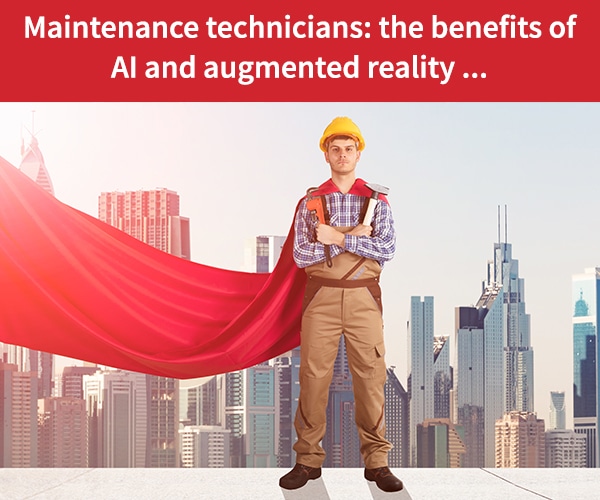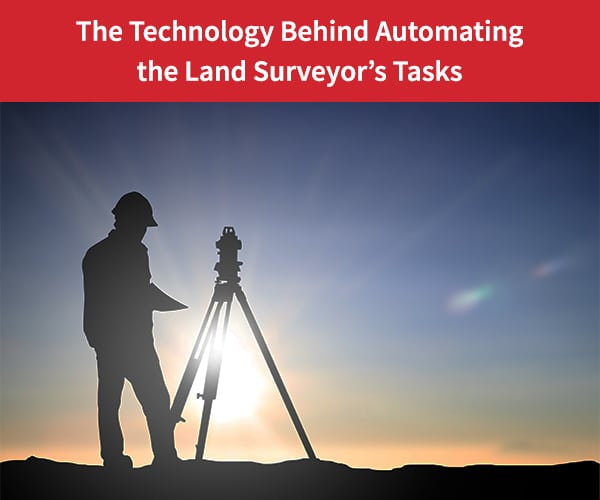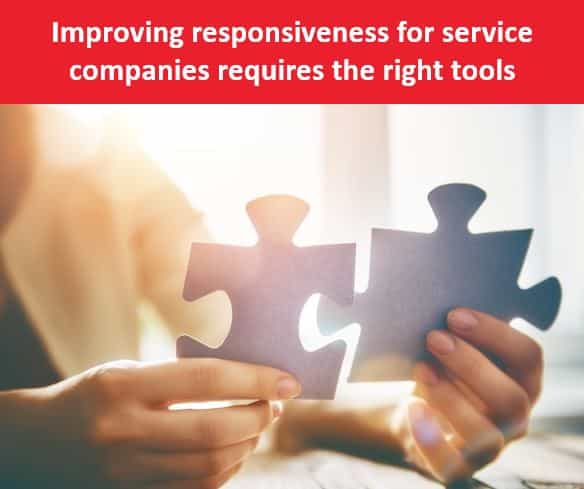
- Artificial Intelligence
- Mobile App
- Productivity
- Technician
How AI and augmented reality give maintenance technicians super powers
New field service technologies not only help on-site technicians make the right decisions, but they also help to improve the accuracy of their actions. The future has arrived! With technologies such as robotics, artificial intelligence, and virtual and augmented reality solutions, business processes can be automated and people have assistance to complete their daily tasks. Humans and machines complement one another to create a workforce with superior capabilities compared to either man or machine on its own. Humans bring their creativity and spirit of innovation while machines bring computer power and the ability to work indefinitely without becoming tired of repeating the same tasks.
When workers incorporate new field service technologies in the right way, they become augmented, or amplified, in their capabilities. These positive benefits counter the common image of a dark, technology-driven future. According to some experts, using artificial intelligence (AI) and robots will eliminate a large number of jobs. The most pessimistic studies say that up to one in two jobs will be eliminated, but these studies don’t consider the jobs that this same digital revolution will create.
Another misconception is that only white-collar workers — those in intellectual professions and executive or supervisory positions are affected by digital transformation. This is not true. The so-called “augmentation” technologies also enhance the physical and mental abilities of blue-collar workers. To illustrate this evolution, Accenture published a very interesting report that describes a day in the life of a technician in a time of disruptive technologies.
Anticipate breakdowns, improve service planning
This field service digital transformation is particularly applicable to maintenance technicians who enjoy new superpowers that are far beyond those of the smartphone or tablet they carry wherever they go. Even before the service request is triggered, machine learning and deep learning algorithms come into play, performing real-time data analysis of the data sent back by temperature, humidity, vibration, and pressure sensors on customers’ equipment
The prediction models applied by the algorithms use the continuous flow of measurements from sensors to detect the warning signs of potential failure and make recommendations about the actions to take. The objective is to anticipate breakdowns before they occur.
Predictive maintenance is a virtuous circle
Predictive maintenance technology improves the lifespan of customer equipment to significantly reduce on-site service requirements. In addition, depending on the state of the equipment and the recommendations of the field service AI software, technicians can sometimes also make repairs remotely, for example by applying a hotfix.
The ability to start remote maintenance processes helps to eliminate unnecessary trips to customer sites and reduce equipment downtime. In this way, it’s similar to a helpline technician who can remotely control a user’s workstation, except there’s no one on the other end of the line to ask about the causes of the breakdown.
Immerse yourself in the future
If, in spite of all efforts, a service call is necessary, the technician arrives at the customer site with detailed insight into the equipment state. In addition, the technician can review the fault history for the same types of equipment and take only those spare parts that are most likely to need replacement, using spare parts management software.
Maintenance training is crucial for effectively utilizing new tools and technologies. Integrating AR maintenance training offers technicians hands-on experience in a simulated environment, enabling them to become familiar with new equipment and procedures without any risk
Before technicians travel to the site, they can use a virtual reality helmet or AR glasses for field service solutions to familiarize themselves with the operating environment and find out where the defective equipment is located. By using AR technology they can even practice the actions they will have to perform as many times as required and make mistakes with no worries of the resulting danger those errors could cause. The mixed reality capabilities provided by Microsoft’s HoloLens technology allow technicians to interact with virtual objects as if they were real.
Use artificial intelligence to help with scheduling
Artificial intelligence can also be used to enhance field service scheduling. Metaheuristic algorithms, such as those used by Praxedo in its SmartScheduler software, consider a large number of factors and can generate optimized schedules. For example, smart field service scheduling considers:
- The type of service required
- The expected duration of the service call
- Travel time and traffic conditions
- Technician skills and availability
- Spare parts inventory levels
This time, it’s service schedulers who are augmented with technology.
Use augmented reality to put information in technicians’ view
But, back to our on-site technician. He’s now with the equipment that needs to be fixed. This is where the augmented reality field service management solution comes into play. The technician can wear his AR glasses for field service tasks to see contextual information that’s superimposed on the real world.
There’s no need for smartphones or tablets. Technicians have hands-free access to the list of tasks to be performed. They can check the data that indicates equipment status, as well as technical documentation such as schematics, data sheets, and instruction manuals, at any time.
Call on remote experts
Technicians can also be “augmented” by their colleagues. While testing 5G applications “in real-world conditions” in Bordeaux last July, Bouygues Telecom demonstrated how a maintenance technician equipped with a HoloLens helmet could receive guidance from a colleague who was about 10 km away. If technicians don’t have the right spare part in their vehicle, they can always use their 3D printer to “print” it on-site. All they need to do is download the correct print file.
Leverage exoskeletons to improve working conditions
New field service technologies can eliminate tasks that are repetitive and painful. In many cases, maintenance technicians must lift and carry heavy items. With an external prosthesis that functions as a kind of robotic exoskeleton, technicians can multiply their physical capabilities and effortlessly carry heavy loads. These types of exoskeletons can also provide a seat for technicians who spend most of their time on their feet. No matter how they are used, exoskeletons will improve working conditions for technicians and reduce the risk of musculoskeletal disorders (MSDs). Combining this with maintenance process improvement creates a safer and more efficient workplace.
Our similar articles.
-
- Productivity
- Work Order Management
Ever Wondered How Land Surveyors Keep up with Service Calls?
August 5, 2021 -
- Mobile App
- Work orders
- service companies
- responsiveness
Improving responsiveness with an intuitive scheduling tool and mobile app
April 6, 2022 -
- Field Service Management
- Mobility
- Technician
Four ways to safely implement BYOD for field service
October 11, 2018


